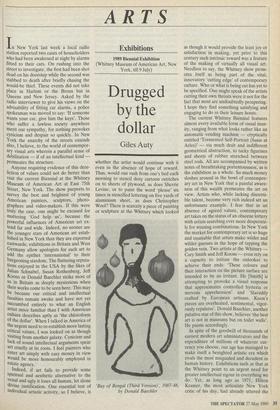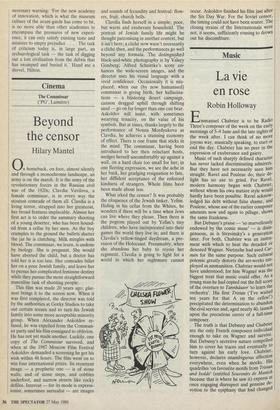ARTS
Exhibitions
1989 Biennial Exhibition (Whitney Museum of American Art, New York, till 9 July)
Drugged by the dollar
Giles Auty
In New York last week a local radio station reported two cases of householders who had been awakened at night by alarms fitted to their cars. On rushing into the street to investigate, the first had been shot dead on his doorstep while the second was stabbed to death after briefly chasing the would-be thief. These events did not take place in Harlem or the Bronx but in Queens and New Jersey. Asked by the radio interviewer to give his views on the advisability of fitting car alarms, a police spokesman was moved to say: 'If someone wants your car, give him the keys'. Those who suffer a lawless society anywhere merit our sympathy, for nothing provokes cynicism and despair so quickly. In New York the anarchy of the streets extends also, I believe, to the world of contempor- ary visual arts wherein a parallel sense of debilitation — if of an intellectual kind permeates the structure.
Anyone requiring evidence of this dere- liction of values could not do better than visit the current Biennial at the Whitney Museum of American Art at East 75th Street, New York. The show purports to survey the best and brightest of young American painters, sculptors, photo- graphers and video-makers. If this were truly the case, one might be excused for muttering 'God help us', because the powerful influences of American art ex- tend far and wide. Indeed, no sooner are the younger stars of American art estab- lished in New York than they are exported eastwards; exhibitions in Britain and West Germany allow apologists for such art to add the epithet 'international' to their burgeoning stardom. The flattering reputa- tions enjoyed in the USA by the likes of Julian Schnabel, Susan Rothenberg, Jeff Koons or Donald Baechler strike most of us in Britain as deeply mysterious when their works come to be seen here. This may be because our critical and intellectual faculties remain awake and have not yet succumbed entirely to what an English artist more familiar than I with American culture describes aptly as 'the chloroform of the dollar'. When I talked in America of the urgent need to re-establish more lasting critical values, I was looked on as though visiting from another galaxy. Cynicism and lack of sound intellectual arguments spear art cruelly at its roots. I feel painters who enter art simply with easy money in view would be more honourably employed in estate agency. Indeed, if art fails to provide some spiritual and aesthetic alternative to the venal and ugly it loses all human, let alone divine justification. One essential test of individual artistic activity, so I believe, is whether the artist would continue with it even in the absence of hope of reward. Thus, would one rush from one's bed each morning to stencil, dozy cartoon ostriches on to sheets of plywood, as does Sherrie Levine, or to paint the word 'please' six times in stencilled lettering on five yards of aluminium sheet, as does Christopher Wool? There is scarcely a piece of painting or sculpture at the Whitney which looked Bay of Bengal (Third Version)', 1987-88, by Donald Baechler as though it would provide the least joy or satisfaction in making, yet prior to this century such intrinsic reward was a feature of the making of virtually all visual art. Needless to say, the Whitney show prom- otes itself as being part of the vital, innovatory 'cutting edge' of contemporary culture. Who or what is being cut has yet to be specified. One might speak of the artists cutting their own throats were it not for the fact that most are undoubtedly prospering. I hope they find something satisfying and engaging to do in their leisure hours.
The current Whitney Biennial features almost every available form of visual inan- ity, ranging from what looks rather like an automatic vending machine — cryptically entitled 'Tormented Self-Portrait (Susie at Arles)' — via much drab and indifferent geometrical abstraction, to tacky figurines and sheets of rubber stretched between steel rods. All are accompanied by written notes of breathtaking portentousness, as is the exhibition as a whole. So much money sloshes around in the bowl of contempor- ary art in New York that a painful aware- ness of this wealth permeates the art on view. Artists who, while lacking discerni- ble talent, become very rich indeed set an unfortunate example. I fear that in an absence of agreed values, contemporary art takes on the status of an obscene lottery with artists searching ever more desperate- ly for winning combinations. In New York the market for contemporary art is so huge and insatiable that artists make wilder and wilder guesses in the hope of tapping the golden vein. Two artists at the Whitney Cary Smith and Jeff Koons — even rely on a capacity to irritate the onlooker to achieve their ends: 'These colours and their interaction on the picture surface are intended to be an irritant. He [Smith] is attempting to provoke a visual response that approximates controlled hysteria or nervous apprehension' and 'Slavishly crafted by European artisans, Koon's pieces are overheated, sentimental, vigor- ously repulsive'. Donald Baechler, another putative star of this show, believes 'the best art is not in museums but on toilet walls'. He paints accordingly.
In spite of the goodwill of thousands of earnest modern art administrators and the expenditure of millions of whatever cur- rency you choose, our age has managed to make itself a benighted artistic era which rivals the most misguided and decadent in human history. Exhibitions such as that at the Whitney point to an urgent need for greater intellectual rigour in everything we do. Yet, as long ago as 1971, Hilton Kramer, the most articulate New York critic of his day, had already uttered the necessary warning: 'For the new academy of innovation, which is what the museum culture of the avant-garde has come to be, is no more able than other academies to encompass the pressures of new experi- ence, it can only satisfy existing taste and minister to empty prejudice . . . . The task of criticism today is, in large part, an archaeological task — the task of digging out a lost civilisation from the debris that has swamped and buried it.' Hand me a shovel, Hilton.



















































 Previous page
Previous page